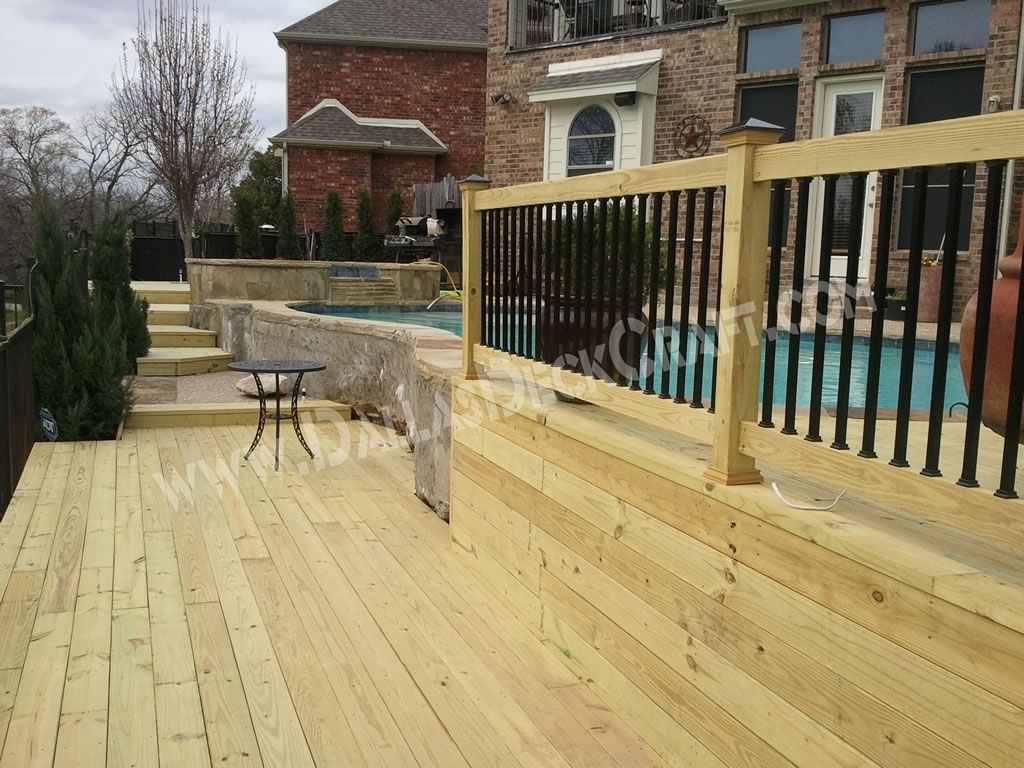- You are here:
- Home »
- Blog »
- Pressure-Treated Decks »
- Is Pressure-Treated Wood the Right Choice for My Outdoor Deck?

Is Pressure-Treated Wood the Right Choice for My Outdoor Deck?
Pressure-Treated Wood Decking is Right in a Lot of Situations
If you’re still considering what kind of material to build your outdoor deck with, chances are you’ve encountered pressure treated wood, or also called Wolmanized pine as a potential option.
As one of the most commonly used materials in outdoor construction projects, pressure-treated wood has an excellent track record as a long lasting, affordable material, making it a deck builder favorite. Pressure-treated pine is commonly used for outdoor decking.
But what is it? What does “pressure treated” mean? Is it right for you? Let’s explore this common building material and find out.
What is Pressure-Treated Wood?
Pressure-treated wood is any kind of wood which has been saturated in a mixture of chemical preservatives. The wood is placed inside a closed tank along with the preservatives, and then the air is sucked out creating a vacuum which forces the preservatives into the wood.
These preservatives are specially designed to protect the wood from pests (such as termites), rot, and wood fungi.
It is important to note that pressure-treated wood still needs to be treated with a weather sealant, as the chemical preservatives generally won’t fare well against weather and aging.
Addressing Safety Concerns of Pressure-Treated Wood
Most of the concerns regarding the safety of the chemical preservatives used to create pressure-treated wood stem from old manufacturing processes which are no longer used.
For many years, chromated copper arsenate (CCA) was the de-facto preservative used in pressure-treated wood—which caught the attention of the Environmental Protection Agency in the early 2000s.
Even though there was some degree of controversy as to how dangerous the use of CCA was if the wood was properly maintained, it has since been banned in residential use, prompting the lumber industry to use safer and more environmentally-friendly preservatives in the creation of pressure-treated wood.
It’s important to remember that if you hear that pressure-treated wood is somehow unsafe, the source is likely using poor or outdated information, as pressure-treated wood using CCA as the preservative hasn’t been sold for residential purposes for at least a decade; it is, however, still used in a variety of industrial applications, which homeowners should be aware of when purchasing pressure-treated wood for their residential projects.
Deck Construction with Pressure-Treated Wood
Pressure-treated wood has been a long-time favorite for deck construction because of its affordable pricing, durability, and how long the wood will last when properly sealed and maintained. When compared to other common woods used in deck construction, pressure treated wood remains a common choice because of its pricing without sacrificing functionality—compared to, say, redwood, pressure-treated wood can cost 30 to 40% less while still retaining all of the benefits of redwood and/or other woods which are well known to be durable.
This comparatively low price bracket means that pressure-treated wood might be a great choice if your deck project is a particularly large one; the savings will add up with every square foot.
Pros and Cons of Pressure-Treated Wood
Pressure-treated wood is one of the most commonly used materials used in outdoor construction—and there’s plenty of good reasons for that. The longevity as well as the durability make it the perfect framing material regardless of what type of material you choose for your outdoor decking needs. While the pros certainly outweigh the cons in most situations, here’s a brief overview of both.
Pros of Pressure-Treated Wood
- Long lasting, many manufacturers offer a 30 or more year warranty
- Very affordable
- Difficult to dent or scratch, strong
- Prevents mold, fungi
- Prevents insects from taking up residence
Cons of Pressure-Treated Wood
- Can only be used outdoors
- When burned, chemicals can be unsafe; poses a potential health hazard in the event of a house fire
